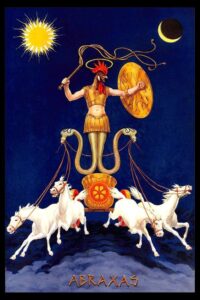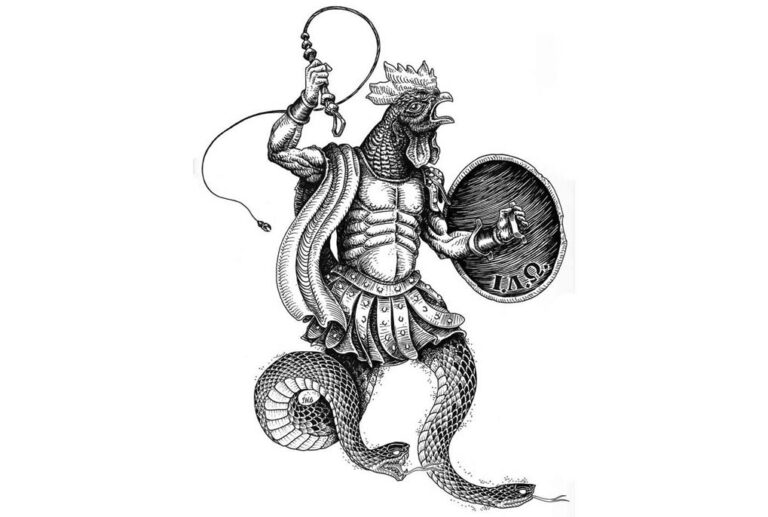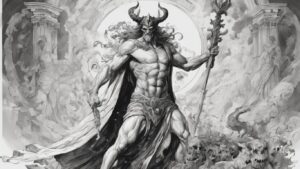Table of Contents
“Abraxas” is a word of mystical and philosophical significance that has been used in various contexts throughout history. It is often associated with Gnosticism, a religious and philosophical movement that emerged in the early centuries of the Common Era.
In Gnostic belief, Abraxas is considered a deity or a higher spiritual being that represents the totality of existence. The word “Abraxas” is sometimes assigned numerical values to its letters, and these values add up to 365, the number of days in a year. This is seen as a symbolic representation of the completeness and unity of existence, encompassing both good and evil, light and darkness, and all aspects of reality.
What is Abraxas used for

It is primarily used as a symbol with deep philosophical and mystical significance, and its use varies depending on the context and belief system in which it is employed. Some of the uses and interpretations of Abraxas include:
Gnosticism: In Gnostic traditions, Abraxas is considered a powerful, complex deity representing the unity of opposites and the totality of existence. It serves as a symbol of the Gnostic worldview, emphasizing the need to transcend dualistic thinking and seek a deeper understanding of the divine and the material world.
Esoteric and Mystical Traditions: Abraxas has been adopted and adapted by various esoteric and mystical traditions throughout history. It may be used as a symbol of spiritual enlightenment, the integration of opposites, and the pursuit of higher knowledge and consciousness.
Talismanic and Amuletic Use: In some cases, Abraxas symbols, such as amulets or engraved gemstones, have been used for protective or talismanic purposes. They are believed to bring the wearer spiritual protection and aid in their pursuit of higher truths.
Occult and New Age Movements: Abraxas has found its way into modern occult and New Age practices as a symbol of spiritual transformation, the balance of opposing forces, and the pursuit of mystical knowledge.
Art and Literature: The image and concept of Abraxas have also appeared in various works of art and literature, often as a symbol of the mysterious and enigmatic aspects of existence.
Philosophical and Psychological Contexts: Some philosophers and psychologists have used Abraxas as a symbol to represent the integration of the human psyche’s contrasting elements and the pursuit of psychological wholeness.
Is Abraxas good or bad?
In Gnostic belief, Abraxas is not categorically good or bad in the conventional sense. Instead, Abraxas represents a more complex and nuanced concept of divinity and existence.
Abraxas is seen as a deity or a higher spiritual being that embodies both the light and the darkness, the good and the evil, and all aspects of existence. This reflects the Gnostic idea that the material world is often a place of duality and conflict, and the ultimate reality is a higher, transcendent unity that encompasses these opposing forces.
So, rather than being strictly good or bad, Abraxas is a symbol of the totality of existence, representing the unity of all things and the need to transcend dualistic thinking. In Gnostic thought, the goal is often to seek a deeper understanding of this divine unity and to transcend the limitations and illusions of the material world.
Symbols of Abraxas
Image of Abraxas: The most recognizable symbol of Abraxas is a creature with the body of a human, the head of a rooster, and sometimes serpents for legs. This composite figure is a central representation of Abraxas in many depictions.
Greek Letters: The word “Abraxas” itself is often written in Greek letters, and each letter is assigned a numerical value. The sum of these values often equals 365, symbolizing the totality of existence. The Greek letters and their associated values are as follows:
Alpha (Α) = 1
Beta (Β) = 2
Rho (Ρ) = 100
Alpha (Α) = 1
Xi (Ξ) = 60
Alpha (Α) = 1
Sigma (Σ) = 200
Serpents: Serpents or snakes are sometimes depicted as part of Abraxas, representing the dualistic forces of creation and destruction, good and evil, and the cycles of life and death.
Sun Disk: In some depictions, Abraxas is shown with a solar or sun disk behind its head, symbolizing the light or divine aspect of this complex being.
Whip or Flail: In certain representations, Abraxas may hold a whip or flail, symbolizing its dominion over the forces of fate and destiny.
Shield and Spear: Sometimes, Abraxas is depicted with a shield and spear, signifying its protective and combative aspects.
Catholicism
Abraxas is not a concept or figure that plays a role in mainstream Catholicism. Instead, Abraxas has its origins in Gnostic belief systems, which were considered heretical by the early Christian church. Gnosticism is a complex and diverse set of beliefs that emerged in the early centuries of the Common Era and had many variations. It often diverged significantly from the doctrines of mainstream Christianity, including Catholicism.
In Gnostic thought, Abraxas represents a deity or concept that embodies the unity of opposites, the duality of good and evil, and the transcendence of conventional dualities. Gnostics believed in a complex cosmology where the material world was often seen as a flawed creation and the true divine reality was hidden and could only be accessed through knowledge (gnosis). This perspective was at odds with the orthodox Christian belief in a singular, benevolent God and the material world’s goodness.
Catholicism and other mainstream Christian denominations have historically rejected Gnostic teachings as heretical. While Gnosticism existed in the same early Christian period, it was considered a heterodox and unorthodox interpretation of Christian teachings.
Mythology and Psychology
Abraxas is a concept that has made its way into various mythological and psychological contexts, especially in the realms of modern mythology and psychology, often associated with the ideas of Carl Jung.
Psychological Significance (Carl Jung): Carl Jung, a Swiss psychiatrist and founder of analytical psychology, introduced the concept of Abraxas in his exploration of the human psyche. He saw Abraxas as a symbol of the union of opposites, representing the totality of the self, which encompasses both light and dark, good and evil, and all dualities. Jung believed that recognizing and integrating the shadow aspects of one’s personality was essential for personal growth and individuation. In this context, Abraxas serves as a symbol of wholeness and the integration of the unconscious into consciousness.
Modern Mythology and Esotericism: Abraxas has found a place in various esoteric and mystical belief systems. In modern mythology and occultism, Abraxas is often depicted as a powerful, transcendent being that unites opposites and holds mystical significance. This interpretation has been influenced by Gnostic thought and Jungian psychology, where Abraxas represents the reconciliation of conflicting forces.
Literature and Popular Culture: The concept of Abraxas has made appearances in literature and popular culture. Hermann Hesse’s novel “Demian” explores the idea of Abraxas as a symbol of spiritual awakening and self-discovery. Additionally, in various works of fantasy and occult literature, Abraxas is often used as a mystical or otherworldly entity, embodying the fusion of opposites.
The interpretation and significance of Abraxas can vary widely depending on the context. In Jungian psychology, it serves as a symbol for personal transformation and psychological integration. In esoteric and mystical traditions, it can represent a higher or unifying principle. In literature and popular culture, it can be a versatile symbol, often associated with transcendence and enlightenment.
Stones
The term “Abrasax stones” refers to a type of amulet or talisman from the ancient world, particularly from the Greco-Roman period, that features engraved images or inscriptions related to the concept of Abraxas. These stones are also known as “Abrasax gems” or “Abrasax talismans.” They are notable for their religious and mystical symbolism and are often associated with Gnostic and early Christian beliefs.
The Abrasax stones typically feature an image of a being with a human body but often a rooster’s head or a serpent’s head, and they may hold various symbolic elements like a shield and whip. The Greek word “Abrasax” is often inscribed on these stones.
The significance of the Abrasax stones lies in their representation of the complex and dualistic nature of the divine as understood by certain Gnostic sects. The name “Abrasax” is often associated with a deity or concept that embodies the unity of opposites, reconciling good and evil, light and dark, and other dualities. The rooster’s head is thought to symbolize the sun, while the serpent’s head represents the moon, further emphasizing this balance between opposing forces.
Abrasax stones provide insight into the religious and mystical beliefs of the time, particularly in the context of Gnosticism and related traditions. They are often studied by historians, archaeologists, and scholars of religion to better understand the spiritual and symbolic aspects of the ancient world.
Abraxas FAQ
What does Abraxas mean?
The term "Abraxas" is a mystic word of power without a specific linguistic meaning, associated with the synthesis of opposites in Gnostic philosophy.
Who is Abraxas in the Bible?
Abraxas is not mentioned in the Bible. The concept is more closely tied to Gnostic beliefs, exploring a complex understanding of divinity outside mainstream Christian traditions.




